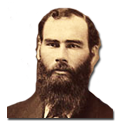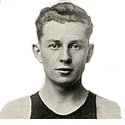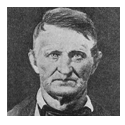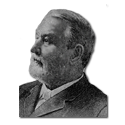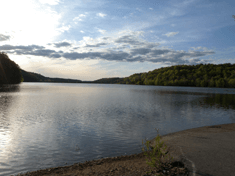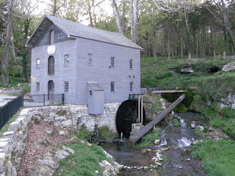Public Meetings & Events
-
Board of Works
10-14-2025 5:00 pm -
Common Council
10-14-2025 5:30 pm -
Board of Works
11-10-2025 5:00 pm -
Common Council
11-10-2025 5:30 pm -
Board of Works
12-08-2025 5:00 pm -
Common Council
12-08-2025 5:30 pm
- Details
John Hay
(1838-1905)
John Hay was born in Salem an became an American statesman, diplomat, author, journalist, and private secretary and assistant to Abraham Lincoln. Hay's highest office was serving as United States Secretary of State under Presidents William McKinley and Theodore Roosevelt.
Benjamin Franklin Trueblood
(1847-1916)
Trueblood was born of Quaker parents on November 25, 1847 in Salem. Trueblood graduated from Earlham College in 1869 and would later become the iconic leader of the American Peace Society based in Boston. Upon his death in 1916 it was stated that "He was truly a great man; a man who gave his life for a noble cause, the cause of Peace. In the generations to come Dr. Trueblood will be looked back upon as one of the World's greatest thinkers, one of the men who live for their fellowmen, the men who have a vision which most people cannot have."
Everett S. Dean
(1898-1993)
Born in nearby Livonia, Dean played basketball for three years at Indiana University and was named the 1921 Helms Athletic Foundation All-America team. Dean has the distinction of being the first basketball All-American from Indiana University.
Dean later became the head baseball and basketball coach at Indiana University. In 1938, Dean was named head basketball coach at Stanford University. Dean coached the 1942 Stanford Basketball team to a NCAA Championship. Dean was also named baseball coach at Stanford in 1950, and led Stanford's baseball team to the 1953 College World Series.
Dean is the only coach inducted in both the Naismith Basketball Hall of Fame and the College Baseball Hall of Fame. He was inducted into the Indiana Basketball Hall of Fame in 1965.
Isaac Blackford
(1786-1859)
After graduating from Princeton University, Blackford came on horseback to the Indiana Territory to practice law. In 1812 Blackford arrived in Salem, where he worked as Washington County’s first clerk and recorder before being elected Clerk of the Territorial Legislature in Corydon in 1813.
Blackford was Indiana’s longest-serving Supreme Court justice and the author of the Blackford's Reports detailing the state’s first court decisions.
John Hay Farnham
(1791-1833)
John Hay Farnham was a Harvard educated Attorney that arrived in Salem to practice law in the 1820's. At the 50th Anniversary of American Independence Farnham made a controversial speech to Salem Residents. Farnham lobbied residents for increased taxes to pay for "common schools" in Salem. The residents of Salem could not follow the justice of taxation on their own property for the education of children of those residents who had no property for taxation.”
Farnham later became the first Secretary of the Indiana Historical Society. He is buried in Crown Hill Cemetery in Salem.
Ladies Piano Club of Salem
(1896)
The Ladies Piano Club of Salem was one of the earliest female social organizations in the state. The social club brought an appreciation for music to the women of Salem.
Lee Wiley Sinclair
(1836-1916)
Sinclair built the largest woolen mill in southern Indiana in Salem. Sinclair also expanded his holdings to another textile mill in Chicago and a department store in Salem.
Thomas Jackson Rodman
(1816-1874)
Rodman was born on a farm near Salem. He was an artillerist, inventor, ordnance specialist, and career United States Army officer. He served as a Union Army general during the American Civil War. Rodman is especially remembered for developing the Rodman gun, which in various sizes saw extensive use in coastal defenses, and was called the "strongest cast iron cannon ever made."
General Rodman also discovered the use of shaped gunpowder grains, in which properly compressing and shaping the gunpowder into pre-designed grain shapes allowed the control of gas production by the burning gunpowder. This resulted in increased muzzle velocities with lower maximum pressures when compared to performance with conventional ball powder. The Rodman seven perforation grain was named after Rodman, and similar propellant grain shapes are still in use today in artillery, rockets, and automotive airbag inflators.
Washington C. Depauw
(1822-1887)
DePauw was born in Salem in 1822 and went on to build a fortune by investing in ventures such as grain, steel and glass and later supplying these items to the US Government during the American Civil War. At one time DePauw was considered the wealthiest man in Indiana.
- Details
Salem, a mere clearing in the woods when settlers began the job of establishing a seat for the newly-formed Washington County, was to grow through the years as a center of industry, commerce, agriculture, education and a caring community that continues to provide a safe haven to thousands of residents who are proud to call it home.
William Lindley, a land surveyor who had already built a cabin just south of Blue River, hosted a group or men who were sent to pick a site for the town. His expertise helped them decide on the location of present day Salem. While meeting with them and during discussion for a town name, Mrs. Lindley suggested Salem, as that had been the name of the Lindley’s hometown in Winston-Salem, North Carolina. Her suggestion was accepted.
In a short time word had spread about the new town. Pioneers crossed the Ohio River and made their way along buffalo and deer trails to the accumulation of cabins and sheds that were popping up around an early form of the present day town square.
Salem officially came to be in 1814. It was here that local government ruled a county that included parts of Orange, Scott, Jackson and a corner of Lawrence counties. Later the county was reduced in land area to its present size.
For much of its existence, the center piece for Salem’s town square has been the county courthouse. The first, built on pillars, gaining it the nickname “Stilted Castle of Justice,” opened in 1816, but by 1824 was deemed unsubstantial and was ordered replaced. The present day courthouse -- the third at that location -- opened in 1888, a spectacular structure that today stands as one of the crown jewels among Indiana’s 92 courthouses.
Salem grew rapidly, thriving on agriculture, and the products of its mills and tanneries.
By the mid-1840s, frustrated by efforts to ship goods and to travel on narrow, muddy trails, businessmen proposed establishing a railroad between Salem and the Ohio River. In 1847, meeting with New Albany businessmen at New Providence, now Borden, they organized the New Albany & Salem Rail Road. January 14, 1851, the first train arrived in Salem, marking the completion of the line and providing a major link for Salem to the outside world.
Ambitious organizers decided to continue railroad construction all the way to Lake Michigan, accomplishing this goal by 1854. Later the railroad would become the Monon Railroad, serving much of the state of Indiana.
In the mid- to late-1800s, Salem gained a reputation as a center for education, drawing young scholars from throughout southern Indiana to its high schools and colleges.
Among its most important contributions to the state, nation and, in some cases, the world, were individuals who became leaders in education, business, industry, medicine, government, the military and life in general.
The town attracted much attention as home to such notables as John Milton Hay, who became personal secretary to President Abraham Lincoln and twice U.S. secretary of state under Presidents McKinley and Roosevelt; several governors, a U.S. Senator and people of vision such as Lee W. Sinclair, who built the world-acclaimed West Baden Springs Hotel in 1901.
Throughout its history, the town has thrived on the abundance of timber available in the area. Several major manufacturers, including Smith Cabinet Company, for years the county’s largest employer, and O.P. Link Handle Company, that long held the distinction of being the world’s largest producer of wooden handles for tools, relied on timber from the area.
Following World War II there was more emphasis on other types of products, plastics and textiles, paving the way for additional industrial growth.
While agriculture continues to be a major factor in the area’s economy, the diverse selection of industry now calling Washington County home continues to provide residents with steady employment.
As a city, Salem has grown and thrived, today boasting excellent schools, major employers, a strong business climate, museums, housing developments, parks, playgrounds and other facilities that provide for the leisure activities of all ages. Excellent highways offer easy access to metropolitan areas.
For additional information on the history and residents of Salem and Washington County, Indiana please visit the Stevens Memorial Museum located on the grounds of the John Hay Center in Salem, Indiana.
- Details
The John Hay Center
(includes the following)
The Stevens Memorial Museum

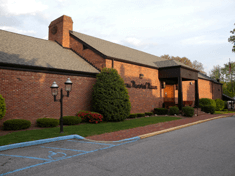 The Stevens Memorial Museum was built in 1970 to preserve community history and heritage. A major expansion was completed in 1995. The beautiful two-and-one-half story brick building is built of native brick from local old historic buildings. The museum features old-time law and dentist offices.
The Stevens Memorial Museum was built in 1970 to preserve community history and heritage. A major expansion was completed in 1995. The beautiful two-and-one-half story brick building is built of native brick from local old historic buildings. The museum features old-time law and dentist offices.
There are hundreds of native historic relics. Many Civil War mementos are included along with tools, agriculture tools and items, beautiful furniture, clothing and other displays. Visitors will find it historically educational and fulfilling in developing an association with the lives of our ancestors.
 The Pioneer Village
The Pioneer Village
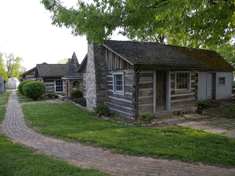 The Pioneer Village is an extension of the Stevens Memorial Museum and has been reconstructed as a "living village" during the 1840's era. Visitors find a visit to the village a challenge to their imagination of the way of life for early settlers. Thomas Hopper is credited with being the first settler to what is now Washington County. George Brock was the first man to settle in the immediate vicinity of Salem. From early settlements came men and women who prominently figured in the development of Washington County.
The Pioneer Village is an extension of the Stevens Memorial Museum and has been reconstructed as a "living village" during the 1840's era. Visitors find a visit to the village a challenge to their imagination of the way of life for early settlers. Thomas Hopper is credited with being the first settler to what is now Washington County. George Brock was the first man to settle in the immediate vicinity of Salem. From early settlements came men and women who prominently figured in the development of Washington County.

The John Hay House
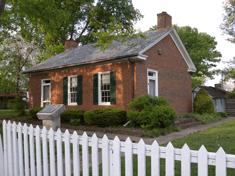 The John Hay House was built in 1824 and was the birthplace of John Hay, private secretary to President Abraham Lincoln ,1861-1865, Writer/Author, 1870-1890, Life of Lincoln and many poems. Mr. Hay was also Ambassador to England; and Secretary of State under President McKinley, 1898, and President Roosevelt, 1902.
The John Hay House was built in 1824 and was the birthplace of John Hay, private secretary to President Abraham Lincoln ,1861-1865, Writer/Author, 1870-1890, Life of Lincoln and many poems. Mr. Hay was also Ambassador to England; and Secretary of State under President McKinley, 1898, and President Roosevelt, 1902.
Genealogy and Historical Library
The Stevens Memorial Museum also houses the Washington County Historical Society Genealogy and Historical Library. Many researchers from all over the United States come here to work on special projects. A small library staff is available to work with researchers. The library not only contains Indiana and local records but also maintains data and records from other states. Types of data included are: family histories, church records, cemetery records, obituaries, census records, marriage records, newspapers, state and county histories and antique photographs.
The Depot Railroad Museum

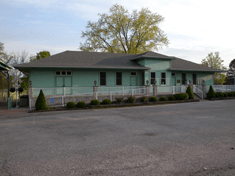 The Depot Railroad Museum stands as a tribute to and reminder of Salem’s role in organizing the railroad that served much of Indiana for 125 years. Known as “The Hoosier Line” because its tracks were located in the state of Indiana, the "Monon Railroad" was founded because of the efforts of Salem businessmen.
The Depot Railroad Museum stands as a tribute to and reminder of Salem’s role in organizing the railroad that served much of Indiana for 125 years. Known as “The Hoosier Line” because its tracks were located in the state of Indiana, the "Monon Railroad" was founded because of the efforts of Salem businessmen.
The Depot Museum contains antique furniture from railroad stations, including the original waiting room benches from the Salem station that was torn down in 1982. Also, there are displays of railroad equipment and tools, signs, advertisements, signals and lanterns. A worker’s motor car and a station’s baggage wagon are on display. The Depot’s basement contains an HO scale model railroad that depicts Washington County as it was in the 1950s and 1860s. A team of volunteers is rebuilding Salem, Pekin and Campbellsburg as they were a half century ago.
For additional information please visit: http://johnhaycenter.org
Washington County Courthouse & Salem Town Square
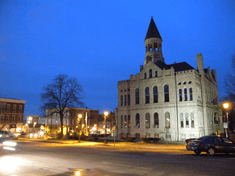
The Washington County Courthouse in Salem, Indiana is a Richardsonian Romanesque building that was built in 1886. It is located within the Salem Downtown Historic District.
Knobstone Trail
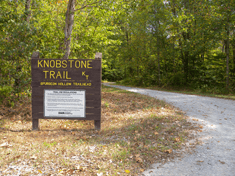
The Knobstone Trail is the longest hiking trail in Indiana. Its southern terminus is located in the Deam Lake State Recreation Area. It currently ends at Delaney Creek Park near Salem, Indiana, however there are plans to eventually extend the trail another 80 miles north to Martinsville, Indiana. As it lies along the Knobstone Escarpment, it is a difficult hike, which is why many use the Knobstone Trail to prepare for hiking the Appalachian Trail.
John Hay Lake
John Hay Lake is a 210-acre surface area lake located, in the Rush Creek Valley, 6 miles northwest of Salem. The lake offers tournament fishing or just a day of leisurely angling. This primitive area is also great for observing birds and animals in their natural habitat. Lake access includes one boat ramp.
A City of Salem boat launch permit is effective for one (1) calendar year, January 1 to December 31. The permits are issued at Salem’s Clerk-Treasurer’s office and the Salem Police Department office. The launch permit is good for both Lake Salinda and John Hay Lake. A valid Indiana fishing license is also required.
Please Note: Since this is a drinking water source, the use of gasoline powered motors is banned, only electric trolling motors are allowed.
Any questions pertaining to the boat permit should be directed to the City of Salem Clerk-Treasurer’s office at 812-883-4264.
Salem's Carnegie Library

Salem secured a grant of $16,000 from the Carnegie Corporation of New York in February 1904 and broke ground in August of 1904. The Salem Library opened in July 1905 and is still in use today as the Salem Community Library. The Carnegie Library in Salem is one of just one hundred in the state of Indiana still being used for its original purpose. Indiana received more than 160 grants from the Carnegie Corporation of New York to build public libraries (more than any other state).
Lake Salinda
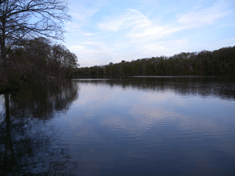 Lake Salinda is an 88 acre surface lake, owned by the City of Salem, located 2 miles south of Salem on S.R. 135. Salinda was once the primary drinking water source for Salem residents and is now the back-up source.Lake Salinda offers tournament fishing and serves as a popular fishing spot for area anglers. Lake access includes one boat ramp.
Lake Salinda is an 88 acre surface lake, owned by the City of Salem, located 2 miles south of Salem on S.R. 135. Salinda was once the primary drinking water source for Salem residents and is now the back-up source.Lake Salinda offers tournament fishing and serves as a popular fishing spot for area anglers. Lake access includes one boat ramp.
A City of Salem boat launch permit is effective for one (1) calendar year, January 1 to December 31. The permits are issued at Salem’s Clerk-Treasurer’s office and the Salem Police Department office. The launch permit is good for both Lake Salinda and John Hay Lake. A valid Indiana fishing license is also required.
For your walking, running or jogging pleasures, the road from the boat launch area to the dam is marked at ¼ mile intervals, for a total of 1 ½ miles back and forth. For exercise or health reasons, you will know how far you’ve traveled.
Lake Salinda has two shelter houses, a pavilion, men's & women's restrooms and eight grills. You may reserve a shelter house, at no cost, by calling the City of Salem’s Mayor’s Office at 812-883-4265. Fishing, reunions, weddings and picnics are a few good reasons to take advantage of this beautiful lake area. Shop Salem for your picnic supplies and then head south two miles for a wonderful day of fun and relaxation.
Please Note: Since this is a drinking water source, the use of gasoline powered motors is banned, only electric trolling motors are allowed.
Any questions pertaining to boat launch permits should be directed to the City of Salem Clerk-Treasurer’s office at 812-883-4264.
Blue River Scenic River System
(Indiana's First State Designated Natural and Scenic River System)
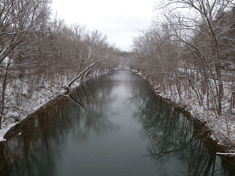
The Blue River originates in Washington County northeast of Salem Indiana and flows south to form the natural boundary between Crawford County and Harrison County, Indiana.The Blue River continues south to the Ohio River.
The Blue River was designated as Indiana's First State Natural and Scenic River System and is a favorite outdoor recreation destination in Indiana.
Salem Speedway
The Salem Speedway has developed a strong racing heritage and tradition that continues today. Some of the top names in open wheel and stock car competition visit the famed high banks each racing season to challenge the demanding .555 mile oval.
The Salem Speedway officially opened for business on June 22, 1947, with Tommy Hinnershitz winning the 20-lap feature event for AAA "Big Cars" in front of over 7,000 enthusiastic fans that packed the grounds for the inaugural Salem Speedway Event.
Since that day in 1947 the names of those who have been raced for the checkered flag at the Salem Speedway continues to grow. Included upon that list are racing legends such as; Ted Horn, Troy Ruttman, Bob Seikert, Parnelli Jones, A.J. Foyt, Bobby Unser, Al Unser, Mario Andretti, Curtis Turner, Benny Parsons, Bobby Allison, Darrell Waltrip, Mark Martin, Rusty Wallace, Alan Kulwicki, Ken Schrader, Tony Stewart, Kenny Irwin, Jr., Jeff Gordon and many others.
For additional information please visit: www.salemspeedway.com
Delaney Creek Park

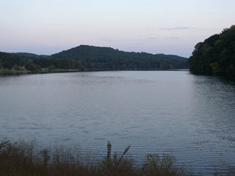
Delaney Park is a 326 acre park with an 88 acre lake with unlimited recreational opportunities including swimming, fishing, boat rentals, nature hikes, basketball, volleyball, horseshoe pits, playground, modern and primitive camping, cabin and lodge rentals, shelter house rentals and the new Delaney Park Restaurant. Access to the Knobstone trail is available from the Delaney Creek Park Trail Head located in the rear parking area of the park.
For additional information please visit: http://www.delaneypark.com/
Beck's Mill Gristmill

The original Beck's Mill was constructed in 1808. That facility served the needs of George Beck's family and the newly arriving settlers until approximately 1825. Then a new and enlarged Mill was reconstructed into a building of approximately 30 feet by 30 feet. The Mill was again rebuilt in 1863-64 and made into this two story structure. The Mill continued to operate until approximately 1950.
In 2005 a group participating in Awareness Washington County, a Washington County leadership development program, decided to explore the possibility of restoring the Mill. As a tribute to the determination of the members and their understanding of the importance of saving such a unique landmark their efforts yielded positive results where others had failed during the 50 years prior.
Beck's Mill is managed by the "Friends of Beck's Mill" a Non-Profit Organization that operates the mill with your admission fees, donations and memberships.
For additional information please visit: www.becksmill.org
Old Settlers' Days

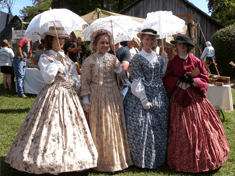
Old Settlers' Days was first held on September 29th, 1875 when local settlers came together to recount in "old fashioned style" the stories, accounts and incidents of the earliest settler families in Salem.
Old Settlers' Days continues to this day to pay homage to the early settlers that migrated to the area and commemorates their rough hewn frontier lifestyles and traditions.
Old Settler's Day is held in late September on the grounds of the John Hay Center. Visitors have the opportunity to see blacksmiths at work, quilting, wood-carving and a variety of local crafts are available for purchase. Historical reenactments encourage visitors to immerse themselves into a Pioneer lifestyle if only for a few hours on a trip to Old Settlers' Days.
DePauw Park & Riley's Place
"Riley's Place" is located inside DePauw Park. DePauw Park is just a few blocks west of the Salem Square. Riley's Place was named after Riley Jean Tomlinson, a local toddler who accidentally drowned in a swimming pool, the park was built in 2001 and contains two and three story wooden castles and other structures for children's play along with swings, slides, and similar playground equipment.
Veteran's Trail at Lake Salinda
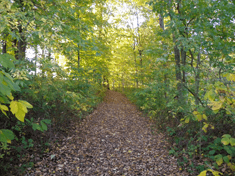
The Veteran's Trail at Lake Salinda is a new hiking trail at Lake Salinda. The trail head for the park is located in the back of the Lake Salinda parking area. The trail is dedicated to those who served in the military.
L.M. Sugarbush Maple Syrup Festival

The LM Sugarbush festival is always the last weekend in February and the first weekend in March. The festival centers around an operating maple syrup camp.
For additional information please visit: http://www.lmsugarbush.com
Salem CenterPeace
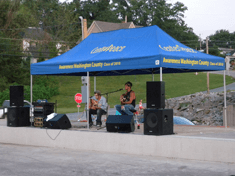
Salem CenterPeace is a community resource for local concerts, farmer's markets and special events. Salem's CenterPeace includes play areas for children.
Brigadier General John Hunt Morgan's Raid Commemorative Markers
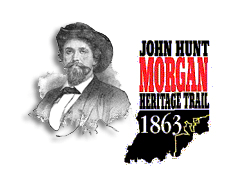
Morgan's Raid was a highly publicized incursion by the Confederate cavalry into Southern Indiana and Ohio during the American Civil War. Morgan's raid took place from June 11–July 26, 1863. Several markers are in place throughout Salem and Washington County to highlight the path taken by Morgan's Raid.
Piper Flight Museum
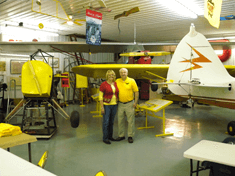
The Piper Flight Center Museum is located at the Salem Municipal Airport in Salem, Indiana. The Piper Flight Museum contains three vintage Piper aircraft, a flight simulator, and a display room with several display cases containing numerous Piper artifacts dating back to the early beginning of Piper Aircraft Corporation.
If you would like to visit the Piper Flight Museum or to schedule a party, meeting or special event please visit their website for additional information.
For additional information please visit: www.piperflightmuseum.org
Early Quaker History & Salem
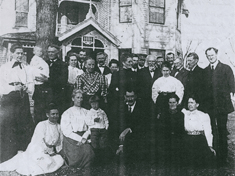
The largest group of settlers in the Salem area in the 1800's were Quakers. The Quakers migrated from the east coast and specifically areas such as North Carolina and Virginia. The trip was made by covered wagon and took about a month from the Carolinas across the Cumberland Gap on the Wilderness Trail.
The Quakers were guided by their religious discipline, agrarian lifestyle, commitment to education, anti-slavery beliefs and following a code of "plain living" that dates back to Quaker conduct rules established in London, England in 1660.
The Hicksite Church building is an early Quaker Church that was also used as a schoolhouse by local Quaker families. This Hicksite Church was erected in 1815 on land donated by Levi Coffin.
Click here for more information on the Blue River Settlement
For additional tourism destinations and tourism information please visit the website for the Washington County Tourism Bureau.















